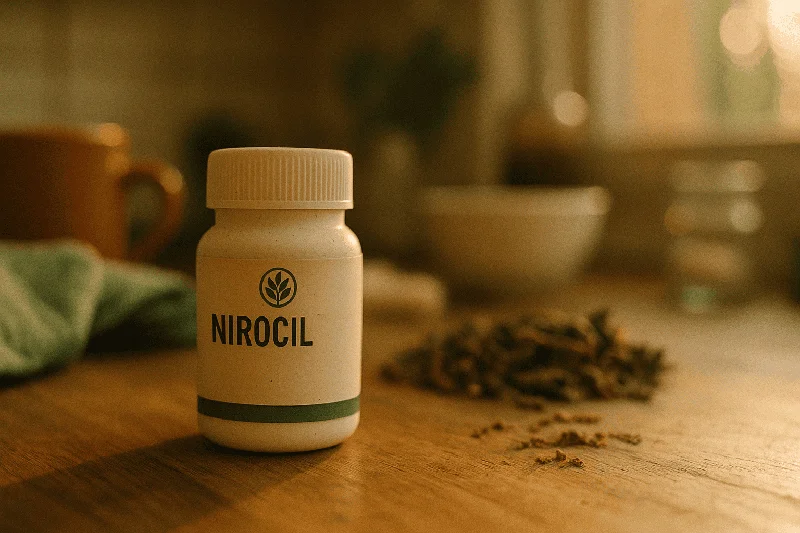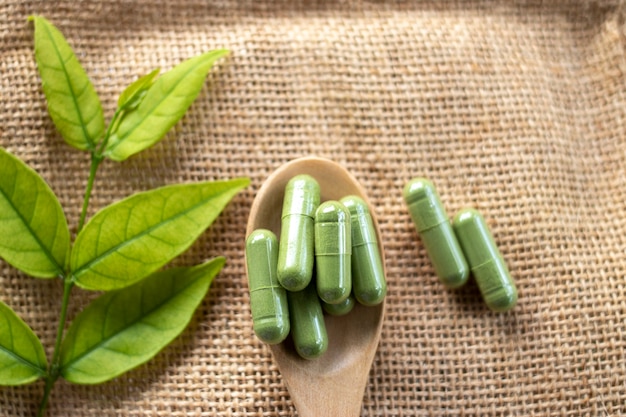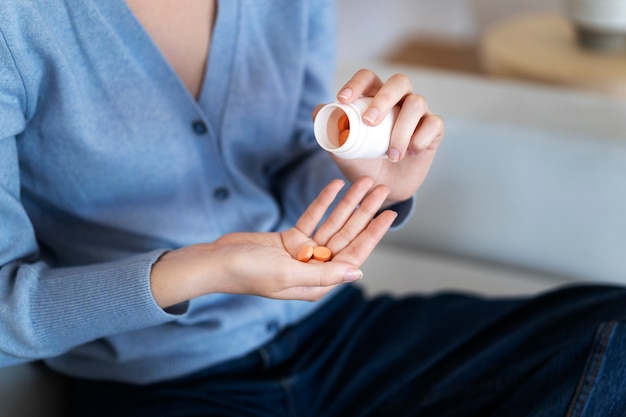Shop Now in Our Store
Nirocil Tab: A Comprehensive Guide to Usage, Benefits, and Research

Nirocil Tab has been gaining attention in healthcare communities for its potential to support immune health and overall well-being. Some practitioners and users attribute its popularity to the blend of ingredients that may help the body fight infections and bolster general vitality. Whether you are a healthcare professional seeking clinical insights or an individual exploring over-the-counter health supplements, this guide aims to provide a balanced, evidence-based perspective on Nirocil Tab.
In this article, we will explore how Nirocil Tab works, review available research, and offer practical guidelines on usage. We will also discuss its safety profile, possible side effects, and frequently asked questions. By the end, you should have a clear idea of where Nirocil Tab fits into an evidence-informed healthcare regimen.
Disclaimer: The information provided here is for educational purposes only and does not substitute professional medical advice. Always consult a qualified healthcare provider before starting any new medication or supplement.
Table of Contents
What Is Nirocil Tab?
Nirocil Tab is marketed as a herbal or herbal-mineral formulation designed to support various facets of human health. Specific products labeled “Nirocil Tab” may vary in exact composition depending on the manufacturer, but they often highlight immune-modulating and anti-infective benefits.
Originating from Ayurvedic and traditional medicine principles, Nirocil Tab typically leverages a synergy of herbs known for their therapeutic properties. With the growing interest in complementary and integrative medicine, Nirocil Tab has drawn attention from individuals looking for natural approaches to maintain wellness. While anecdotal testimonials are abundant, the focus here is on evidence-based data that either supports or questions these claims.
Key Ingredients and Their Potential Effects
The exact composition of Nirocil Tab may differ among brands, but there are several core ingredients commonly associated with its formula. Below are some of the most frequently cited herbal and mineral constituents, along with summaries of potential effects supported by preliminary research:
-
Guduchi (Tinospora cordifolia)
-
Potential Role: Often credited with immunomodulatory, anti-inflammatory, and antioxidant properties.
-
Evidence Base: A Journal of Ethnopharmacology 1 review suggests Guduchi may enhance immune function and help modulate inflammatory responses.
-
-
Tulsi (Ocimum sanctum)
-
Potential Role: Renowned for its adaptogenic properties, Tulsi (also called Holy Basil) is believed to help the body manage stress and bolster respiratory health.
-
Evidence Base: Clinical studies published in the Journal of Ayurveda and Integrative Medicine 2 report possible stress-reducing and respiratory benefits.
-
-
Turmeric (Curcuma longa)
-
Potential Role: Known for its primary bioactive component, curcumin, which exhibits antioxidant and anti-inflammatory activity.
-
Evidence Base: A 2017 meta-analysis in the Journal of Medicinal Food 3 concluded that curcumin can aid in reducing markers of inflammation.
-
-
Giloy (Tinospora cordifolia)
-
Potential Role: Sometimes listed separately from Guduchi, Giloy is traditionally used for fever management and to improve vitality.
-
Evidence Base: Multiple studies, including those in the International Journal of Ayurveda Research 4, indicate immune-stimulating capabilities.
-
-
Other Minerals and Supportive Herbs
-
Potential Role: Depending on the brand, these may include minerals like zinc and herbs like Neem, often recommended for their anti-microbial or immune-support properties.
-
Evidence Base: Zinc is widely recognized in clinical settings to support immune function, as referenced by the World Health Organization (WHO) 5. Neem is often studied for its antibacterial potential.
-
It is crucial to note that while these ingredients individually have a body of evidence supporting potential health benefits, the combined efficacy and safety of multi-ingredient formulations like Nirocil Tab require further rigorous, controlled clinical trials.
Scientific Basis and Mechanism of Action
Immunomodulation:
According to traditional medical systems, certain herbal constituents in Nirocil Tab may help the body self-regulate its immune response. Modern immunology studies suggest herbs like Guduchi and Tulsi may stimulate the activity of immune cells such as macrophages, natural killer cells, and T lymphocytes. This immunomodulatory effect could help in the body’s defense against pathogens, though more large-scale, randomized clinical trials are needed.
Anti-Inflammatory and Antioxidant Effects:
Chronic inflammation is linked to numerous diseases, including cardiovascular conditions and autoimmune disorders. Ingredients such as curcumin (from Turmeric) and Giloy have been studied for their potential to modulate pro-inflammatory cytokines like TNF-α and IL-6. Free radical scavenging properties also help reduce oxidative stress, which is considered a contributing factor in many chronic ailments.
Antimicrobial Properties:
Some laboratory studies demonstrate that certain herbal extracts used in Nirocil Tab might exhibit inhibitory activity against bacteria and viruses in vitro. For instance, Tulsi has shown promise against specific strains of bacteria in test-tube experiments, while Giloy is often cited for its traditional use in managing fevers, sometimes believed to be of viral origin. However, translating these findings into clinical practice remains a work in progress.
Clinical Applications and Research Findings
The broad spectrum of claimed benefits for Nirocil Tab extends from immune support to adjunctive therapy in mild infections. Below is a snapshot of how it is being used and what studies suggest:
-
Immune Support During Seasonal Changes:
Many users turn to Nirocil Tab during periods of seasonal transition (e.g., monsoons or winter) when respiratory infections spike. While anecdotal evidence is positive, clinical trials confirming efficacy are limited.-
Reference: A small-scale observational study in the Journal of Traditional and Complementary Medicine 6noted improved self-reported vitality among participants using herbal formulations containing Guduchi and Tulsi.
-
-
Adjunct in Management of Mild Viral Infections:
Certain practitioners recommend pairing Nirocil Tab with standard therapies for mild viral infections like the common cold. The rationale is that its immunomodulatory and anti-inflammatory properties may help alleviate symptoms and speed recovery.-
Reference: A 2020 pilot study published in Ayurveda Research & Practice 7 found that participants who took an herbal-mineral supplement (including Guduchi and Tulsi) reported quicker symptom relief compared to a placebo group. However, the sample size was small, and further research is required.
-
-
Stress and General Wellness:
Chronic stress can weaken the immune system. Herbs like Tulsi and Giloy might offer stress-adaptive properties, which indirectly support immunity.-
Reference: A systematic review in the Evidence-Based Complementary and Alternative Medicine journal 8cited Holy Basil’s adaptogenic role, emphasizing the herb’s potential in stress management.
-
While initial research is promising, it is not definitive. The consensus among many in the medical community is that Nirocil Tab could serve as a supportive supplement rather than a primary treatment for severe health issues.
Dosage and Administration Guidelines
Because multiple manufacturers produce Nirocil Tab, guidelines may differ slightly. However, common usage instructions typically recommend:
-
Average Adult Dosage: 1–2 tablets, taken once or twice daily with water, after meals.
-
Duration: Often taken for 2–4 weeks for general well-being. Some practitioners suggest a longer course depending on individual health goals.
-
Professional Supervision: Individuals with pre-existing medical conditions (e.g., autoimmune disorders, diabetes, hypertension) or those taking prescription medications should consult a healthcare professional for personalized guidance.
Note: Always adhere to the manufacturer’s label instructions and consult a physician or a qualified Ayurvedic practitioner before use, especially if pregnant, nursing, or taking other medications.
Potential Side Effects and Precautions
Herbal formulations are sometimes perceived as inherently safe because they are “natural.” However, natural substances can still elicit side effects or interact with medications. Potential concerns include:
-
Gastrointestinal Disturbances
-
Some users report mild nausea, stomach upset, or diarrhea. Introducing the supplement with food can minimize these effects.
-
-
Allergic Reactions
-
Ingredients such as Turmeric and Tulsi, though generally well-tolerated, can trigger rare allergic responses in sensitive individuals (e.g., skin rashes, itching).
-
-
Drug Interactions
-
Herbs that modulate the immune system, such as Guduchi, might affect immunosuppressant therapies. Turmeric can enhance the blood-thinning effects of anticoagulant medications.
-
Always inform your healthcare provider about any supplements you are taking to avoid potential interactions.
-
-
Safety in Pregnancy and Lactation
-
Scientific data on the safety of Nirocil Tab in pregnant or breastfeeding women is insufficient. Consult a healthcare professional for case-specific recommendations.
-
Expert Opinions and Guidelines
Because Nirocil Tab is often categorized under dietary supplements or herbal products, it typically does not undergo the same level of regulatory scrutiny as pharmaceutical drugs in many countries. However, certain practitioners and institutions do offer guidelines:
-
Ayurvedic Practitioners’ Consensus: Many Ayurvedic experts emphasize that herbal-mineral combinations, like Nirocil Tab, should be part of a holistic lifestyle that includes a balanced diet, regular exercise, and stress management techniques such as yoga or meditation.
-
Integrative Medicine Clinics: Some integrative health clinics may use Nirocil Tab as a complementary intervention alongside conventional treatments, especially in the realm of immune support. They often rely on patient-reported outcomes and small-scale studies to guide usage, urging larger randomized control trials for conclusive evidence.
-
Regulatory and Health Organizations: Bodies such as the World Health Organization (WHO) and the National Institutes of Health (NIH) have not specifically endorsed Nirocil Tab. However, they do acknowledge that certain herbs like Tulsi and Turmeric have scientifically explored health benefits. This underscores the need for more rigorous clinical trials focusing on multi-ingredient formulations.
Frequently Asked Questions (FAQ)
-
Is Nirocil Tab safe for children?
-
Safety data in pediatric populations is limited. Consult a pediatrician or qualified Ayurvedic practitioner before giving Nirocil Tab to children.
-
-
How long does it take to see results?
-
Response can vary based on individual factors like age, overall health, and lifestyle. Some users report noticing subtle benefits (e.g., improved energy) within a couple of weeks, but consistent use may be needed for more significant effects.
-
-
Can I combine Nirocil Tab with other supplements?
-
Combining multiple herbal formulations can increase the risk of interactions. Always consult a healthcare provider for personalized guidance.
-
-
Does Nirocil Tab cure infections?
-
There is no robust clinical evidence suggesting that Nirocil Tab definitively “cures” infections. It may support immune function, but it should not replace standard medical treatment.
-
-
Is it suitable for long-term use?
-
While some practitioners recommend extended use under supervision, long-term effects have not been well studied. Periodic consultation with a healthcare provider is advisable.
-
Conclusion and Call to Action
Nirocil Tab stands out as a popular option in the world of herbal supplements, especially among those looking for immune support and holistic wellness. While initial research and traditional wisdom underscore potential benefits, large-scale clinical studies are necessary to validate the wide-ranging claims comprehensively. For most individuals, Nirocil Tab may offer supportive benefits when used responsibly and under professional guidance.
If you are considering integrating Nirocil Tab into your health routine, ensure that you discuss it with a qualified medical professional, particularly if you have chronic conditions or are taking other medications. For more up-to-date research, keep an eye on peer-reviewed journals and authoritative medical databases like PubMed.
Ready to Learn More?
-
Share this article with friends or family interested in herbal supplements.
-
Comment below with your questions or personal experiences.
-
Subscribe to our newsletter for more evidence-based articles on integrative medicine and wellness.
By staying informed and consulting with healthcare professionals, you can make educated decisions that align with your health goals while prioritizing safety. Remember, every individual is unique, and personalized care is paramount in any treatment or supplement regimen.
References
Disclaimer: This article is intended for informational purposes only. It is not a substitute for professional medical advice, diagnosis, or treatment. Always consult a qualified healthcare provider regarding any questions you may have about a medical condition or treatment.
Footnotes
-
Journal of Ethnopharmacology(multiple articles on Tinospora cordifolia ). -
Journal of Ayurveda and Integrative Medicine(study on Ocimum sanctum) . -
Journal of Medicinal Food(curcumin and inflammation meta-analysis) . -
International Journal of Ayurveda Research(Giloy’s immune benefits) . -
World Health Organization (WHO) guidelines on zinc supplementation. -
Journal of Traditional and Complementary Medicine(observational study on herbal formulations). -
Ayurveda Research & Practice(pilot study on herbal-mineral supplement ). -
Evidence-Based Complementary and Alternative Medicine(systematic review on adaptogenic benefits of Holy Basil) .
This article is checked by the current qualified Dr Sujal Patil and can be considered a reliable source of information for users of the site.
Got any more questions?
Ask Ayurvedic doctor a question and get a consultation online on the problem of your concern in a free or paid mode.
More than 2,000 experienced doctors work and wait for your questions on our site and help users to solve their health problems every day.




